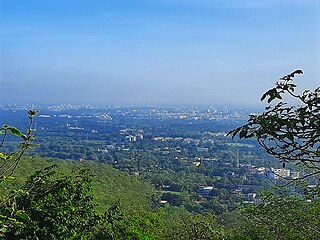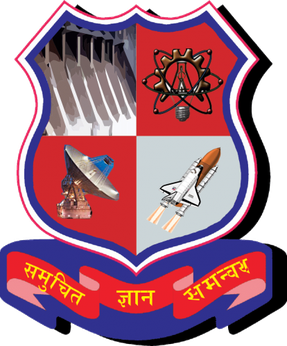Nadiad is a city in the state of Gujarat, India and the administrative centre of the Kheda district. The city is managed by the Nadiad Municipal Corporation. It is known for the Santram Mandir, the Mai Mandir, the historic Swaminarayan temple built in 1824, and the Anand and Hari Om Ashram. Nadiad is the place where Shrimad Rajchandra composed Shri Atmasiddhi Shatra, a 142 verse spiritual treatise in 1895. Nadiad is located 90 kilometres (56 mi) away from Gandhinagar, the capital of Gujarat. It has a major railway junction and is a main station on the Ahmedabad-Mumbai route. It is the birthplace of Sardar Vallabhbhai Patel, the first Deputy Prime Minister of India. Nadiad Municipality was Founded in 1866.

Sabarkantha district is one of the 33 districts of Gujarat state of India, located in the northeastern part of the state. The administrative headquarters of the district are located in Himatnagar.

Mehsana, also spelled Mahesana, is a city and the headquarters of Mehsana district in the Indian state of Gujarat. Established in 14th century, the city was under Gaekwads of Baroda State from 18th century to the independence of India in 1947. Dairy, oil and natural gas are major industries in the city.

Valsad, historically known as Bulsar, is a city and a municipality in Valsad district of the Indian state of Gujarat. It is the district headquarters of Valsad district. Valsad is located south of Navsari and shares border with Maharashtra and the union territories of Dadra and Nagar Haveli and Daman and Diu in the south.
Vallabh Vidyanagar, also known as V.V.Nagar, is a town and a Anand Municipal Corporation in Anand district in the Indian state of Gujarat. It is located between Ahmedabad and Vadodara, 6 km (3.7 mi) from the town of Anand. V.V.Nagar is renowned as an educational hub of Gujarat and is home to the prestigious Sardar Patel University.

Himatnagar or Himmatnagar is a city and the headquarters of Sabarkantha district in the Indian state of Gujarat. The city is on the bank of the river Hathmati.

Mehsana district is one of the 33 districts of Gujarat state in western India. Mehsana city is the administrative headquarters of this district. The district has a population of over 1.8 million and an area of over 4,500 km2. There are over 600 villages in this district with a population of 2,035,064 of which 22.40% were urban as of 2011.
Navsari is the ninth biggest city in the state of Gujarat in India. It is the administrative headquarters of Navsari District. Navsari is situated between Surat & Mumbai. Navsari is a twin city of Surat. It is located 37 km south of Surat. As per 2011 Census of India, Navsari is 16th biggest city of Gujarat state. It ranked 10th most populous city of Gujarat in 1991 Census of India and 2001 Census of India. Navsari is the 25th cleanest city of India according to the Swachh Bharat Urban mission. Dandi village near Navsari was the focal point of the great Salt March led by Mahatma Gandhi during civil disobedience movement of India.
Meghraj is a town in the Indian state of Gujarat.
Dhansura is a small town in the Aravalli district of Gujarat, India. The town is located about 85 km northeast of Ahmedabad. Previously it was a part of Sabarkantha district and now it is part of Aravalli district.
Hemchandracharya North Gujarat University (HNGU) is a public university in Patan, Gujarat, India. The geographical jurisdiction of the North Gujarat University encompasses five districts: Aravalli, Banaskantha, Mehsana, Patan and Sabarkantha. It is NAAC 'A' accredited state university with a CGPA of 3.02.

Krantiguru Shyamji Krishna Verma Kachchh University is a state university in Gujarat, India that promotes higher education in regional and rural areas of the country. It is named after Shyamji Krishna Varma of Kachchh, Gujarat.

Dharmsinh Desai University (DDU) formerly known as Dharmsinh Desai Institute of Technology (DDIT) is a state funded institution in Nadiad, Gujarat, India and was founded on 2 January 1968.

Gujarat Technological University (International Innovative University), commonly referred as GTU, is a public state university affiliating many engineering, pharmacy, and management colleges in Gujarat state, India. The university is headed by the state government and came into existence on 16 May 2007. Engineering institutes such as Lalbhai Dalpatbhai College of Engineering, Birla Vishvakarma Mahavidyalaya, Vishwakarma Government Engineering College and many Government Engineering Colleges are a part of GTU.
Vidyaben Shah was an Indian social worker and activist known for her work with children, women and the elderly in India. While she was already serving as Vice-President, she was appointed the first non-officio President of the New Delhi Municipal Council (NDMC) by Prime Minister Indira Gandhi in 1975. She has held several leading positions in the field of social welfare since the 1940s. Vidyaben Shah died at the age of 97 on 19 June 2020 at her residence in Delhi, her son Mihir Shah confirmed the news of Vidyaben Shah death.

Aravalli district is a district in the state of Gujarat in India that came into being on August 15, 2013, becoming the 29th district of the state. The district has been carved out of the Sabarkantha district. The district headquarters are at Modasa.
Ahmadabad Education Society is a premier educational trust, which has founded many schools and colleges in Ahmedabad, Gujarat, India.

Pravin Darji is Gujarati essayist, poet, critic and editor from India. He was awarded Padma Shri in 2011.

The Indian Institute of Teacher Education (IITE) is a state university located at Gandhinagar, Gujarat, India. It was established in 2010 by the Government of Gujarat and focuses on teacher education. In Gujarat state all 59 government and grant in aid teacher education colleges are affiliated with IITE.
Bhogilal Chunilal Gandhi was an Indian scholar, poet, critic, translator, and independence activist from Gujarat, India. He edited Vishvamanav, a Gujarati-language literary-socio-political journal. He wrote biographies of several writers and political figures including Leo Tolstoy, Joseph Stalin, C. Rajagopalachari, Subhas Chandra Bose, Romain Rolland, Durgaram Mehta, and Narmad. He translated many works into Gujarati from English and Bengali languages. In his early years, he came under the influence of Communism, and became an active member of Communist Party of India.















